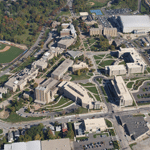In July 2009, Xavier University in Cincinnati set out to eliminate dorm room overcrowding, fill a campus need for more dining space, and do both with sustainability in mind. In just more than two years, the university was able to plan, design, and construct a 265,000-square-foot residential complex to LEED Silver standards. Located at the heart of campus, the structure added 535 dorm room beds and 800 seats for dining.
“Xavier University experienced a growth in enrollment, and we were already short on beds here on campus—we were tripling up our double rooms,” says Joe Frecker, construction manager at Xavier University. “With the construction of Fenwick Place and the Hoff Dining Complex, we would be able to enforce our own rule that all freshman and sophomores need to live on campus.”
The building’s design, meanwhile, reinforces the school’s commitment to sustainability. It uses an envelope panel system to make it weathertight, and tongue-and-groove panels act as an insulation layer and vapor barrier, so once the building was enclosed, the team was able to concentrate on the interior. Bob Sheeran, vice president of facilities, says that an integrated project delivery system allowed Xavier University to bring in certain critical elements of the project early on, including the installation of five elevators by Kone.

At its new residential and dining complex, Xavier University holds energy competitions between wings, which have meters that provide key data, to see which one is using the least amount of energy and encourage the students to conserve.
The structure consists of four wings for dorms and a dining hall in the lower level of the building. To harmoniously combine living and dining in one structure, the kitchen exhaust was fashioned to come up through the middle of the residence hall towers and exhaust five stories above the ground to prevent students from smelling it at ground level. The university installed a Melink system that uses sensors to handle the exhaust by making the fans speed up or slow down as needed. “Having the variation saves energy because every time you turn on the hood, you are sucking energy out of the building and having to replace it with fresh air,” Sheeran says.
Many of the LEED credits for the structure came through using low-flow toilets and showers and daylighting. “The building uses 20 percent less water because of the flow restrictions, and the living areas and lounges get significant daylight,” Sheeran says.
Xavier University invested in state-of-the-art building management systems in its new central utility plant. Mechanical and electrical systems were dedicated to water efficiency, energy conservation, and the quality of the indoor environment. “Even though we increased our square footage on campus by 25 percent, our utility bills remained the same because of the efficiencies we received from the new equipment,” Frecker says.
Since the project’s completion in August 2011, the complex has been able to energize the core of campus. “It was the tooth missing in our smile,” Sheeran says. “There was a void on campus that Fenwick Place and the Hoff Dining Commons was able to fill.”

